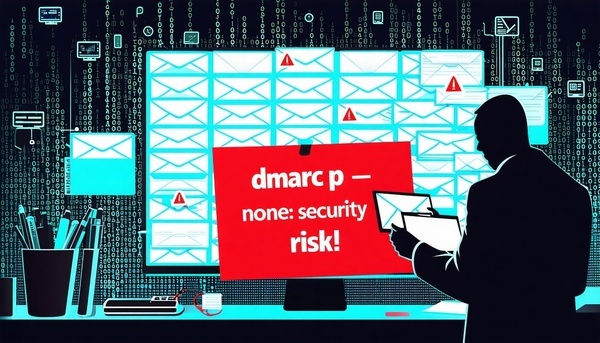
Why “p=none” in DMARC Leaves Your Email Exposed
DMARC (Domain-based Message Authentication, Reporting, and Conformance) is a critical email security protocol designed to protect domains from spoofing and phishing attacks. However, one of its policy settings—p=none—creates significant security vulnerabilities that many organizations fail to recognise.
This article explains why p=none is problematic and what IT professionals should do about it.
Understanding DMARC Policies
DMARC offers three policy enforcement levels:
- p=none: No action taken on failed authentication
- p=quarantine: Failed emails sent to spam/junk folder
- p=reject: Failed emails blocked entirely
While p=none might seem like a safe starting point (and it IS - for short periods!), it creates serious security gaps that can be exploited by malicious actors.
The Core Problem with p=none
No Protection Against Spoofing!
The fundamental issue with p=none is that it provides zero protection against email spoofing (spoofing is when an email is sent using a valid domain, but the sending server is not authorised for that domain). With a DMARC record is set to p=none, receiving mail servers are instructed to take no action against any email that fails an authentication check, effectively allowing any sender to impersonate your domain without penalty or detection - yes, that absolutely means that ANYONE could accurately impersonate ANY email address on your domain with this setting in place!
This creates a false sense of security—organisations believe they have DMARC protection (as many SaaS platforms will give a "green tick" and even suggest this entry!) when they the reality is they actually have none!
As one security expert notes,
having a DMARC record set to p=none is essentially equivalent to not having a DMARC record at all.
Well, we'd actually like to challenge that - it is actually WORSE than not having a DMARC record!
Worse Than No DMARC at All
Surprisingly, p=none can be more dangerous than having no DMARC policy whatsoever. Here's why:
- Email gateways that strictly follow RFC standards may ignore SPF and DKIM failures when p=none is present
- Without DMARC, some mail servers would still respect SPF hard fail (-all) settings
- With p=none, the DMARC policy can override these existing protections
- This means that implementing p=none might actually weaken your existing email security rather than strengthen it.
Business Impact of p=none
Domain Reputation Damage
When attackers successfully spoof your domain due to p=none policies, several negative consequences occur:
- Legitimate emails may be marked as spam due to poor domain reputation
- Customer trust erodes when phishing emails appear to come from your organization
- Brand damage occurs as your domain becomes associated with malicious activity
Increased Attack Surface
Domains with weak DMARC policies are specifically targeted by Cyber criminals (yes, this as these settings are in DNS, they are easily searched and visible by everyone!). Research shows that bad actors actively hunt for domains with p=none policies because they know these domains can be easily spoofed for phishing and spam campaigns.
When p=none Might Be Appropriate
While p=none is generally problematic, there are a few (limited!) scenarios where it serves a legitimate purpose:
- Initial DMARC Implementation.
Organisations just beginning their DMARC journey may/should use p=none temporarily to:- Monitor email authentication patterns without risking legitimate email delivery
- Identify all authorised sending sources before implementing stricter policies
- Gather baseline data through DMARC reports
- Complex Email Infrastructure
Large organizations with decentralized email systems might use p=none during transition periods to:- Map multiple sending sources across different departments
- Test authentication configurations with third-party vendors
- Avoid disrupting critical transactional emails during policy rollout
- There is NO OTHER VALID REASON!
Getting Beyond p=none
Gradual Policy Enforcement
The recommended approach is to transition gradually from p=none to stricter policies:
- Start with p=none only for initial monitoring (days or weeks, not months - we recommonend <14 days)
- Move to p=quarantine once you've identified all legitimate senders (again, this should be done in <14 days, unless you have a PLETHORA of sending locations, in which case you have probably have a BIGGER problem and need to consider rationalising toolsets, or implementing secure smarthosts!)
- Implement p=reject for maximum protection after thorough testing
Key Indicators for Policy Advancement
You're ready to move beyond p=none when you have:
- Consistent DMARC reporting showing clear authentication patterns
- Confidence in authorised senders with proper SPF and DKIM alignment
- Minimized false positives in your authentication checks
Microsolve Practices for DMARC Implementation
Avoid the p=none Trap!
- Set timeline limits for p=none usage (typically 14-28 days maximum)
- Monitor reports actively rather than passively collecting data
- Plan your enforcement strategy before implementing DMARC
- Implement Comprehensive Monitoring
- Configure aggregate reporting (rua=) to track authentication results
- Set up forensic reporting (ruf=) for detailed failure analysis
- Use DMARC analysis tools to interpret report data effectively
Final Thoughts
While p=none serves a limited purpose during initial DMARC implementation, leaving it in place long-term creates serious security vulnerabilities and is just plain BAD! Organisations using p=none are essentially putting a neon sign up for cybercriminals that their domain is available for spoofing attacks.
The solution is straightforward: p=none is a TEMPORARY monitoring phase, not a permanent security posture. Moving to p=quarantine or p=reject policies allows you to realise DMARC's full protective potential and significantly reduce exposure to email-based attacks.
For IT professionals implementing DMARC, remember that monitoring without enforcement is not security—it's simply expensive data collection that leaves your organization vulnerable to the very threats DMARC was designed to prevent.


